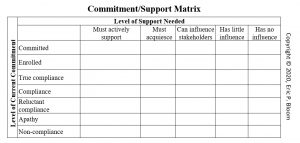For a project to succeed, various groups of people must support it. If one of these groups falls short, then the entire project is at risk. These groups are:
- Project stakeholders who provide people
- Project stakeholders who provide budgets and other resources
- Dotted-line employees working on the project but reporting to other managers
- Compliance and regulatory staff that must approve the project
Project Stakeholders Who Provide People
Dotted-line resources are those who do not administratively report to the person directing their day-to-day work activities. For example, a project manager working with a software developer on loan from the company’s IT department.
If dotted-line resources don’t work directly for you, you must influence them and their administrative manager.
The techniques for influencing and motivating your dotted-line employees are much the same as those used to influence your staff. Influencing the managers of your dotted-line resources requires different techniques, because the goal is different. Your goal for them is to get continued support for your projects. To do so, consider using the following influence techniques:
Influencer #1: Treating resources well
When administrative managers provide resources to other groups, they expect their people to be treated with respect, integrity, and fairness. If you treat your dotted-line resources well, not only will they want to work for you again, but the administrative manager will also be influenced to continue to provide resources for your projects.
Influencer #2: Following administrative manager’s processes
Even though an employee is on loan to your department, their administrative manager is still responsible for their performance reviews, training, career path, and other related manager/employee activities. Do all you can to assist the administrative manager with managerial tasks. Provide job performance input and fulfill any other requests from the administrative manager that make it easier for them to do their job. This cooperation evokes reciprocity, liking, cooperation, and other positive feelings that will make it more likely for the administrative manager to prioritize your needs over those of someone who makes their job more difficult.
Project Stakeholders Who Provide Budgets and Other Resources
In addition to people, projects often need other resources, like access to corporate data, computer equipment, trucks, cash, and other non-human assets.
You must influence these stakeholders in two ways. First, gain their agreement that your project is worthwhile. Second, get them to prioritize your project over other potential recipients of resources. To accomplish this, consider using the following influence techniques:
Influencer #3: Reciprocity
When people loan you resources, providing them some type of ongoing value in return helps ensure your continued use of these resources. This is the case because they feel reciprocal obligation. Their fear is that if they no longer provide you with the resources you need, you will withdraw the ongoing value you are giving to them.
As a simple example, if you provide their department needed client data, this unstated reciprocal agreement can continue as long as this data is of greater value to them than the cost of loaning you their resources.
Influencer #4: Liking
If the administrative manager likes you more than the others they are supporting by lending resources, you are more likely to receive a higher priority when resources become scarce.
Dotted-Line Employees
As previously mentioned, dotted-line resources are people who do not administratively report to the person directing their day-do-day work activities, in this case, you as the PM. Influencing dotted-line employees to work hard on your projects is based on two primary factors: first, motivating employees to produce high quality work; and second, maintaining continued support from their administrative managers, which was previously discussed in the section, “Project Stakeholders Who Provide People.”
If your dotted-line resource is working on multiple projects simultaneously, you must continuously influence them to prioritize your tasks over others. You can accomplish this by making sure your project is a priority for the administrative manager and that you continually communicate with them regarding your project’s importance to the company and/or their career.
Compliance and Regulatory Staff
If you work in a regulated industry, such as financial services or healthcare, there are specialized corporate departments that keep track of these industry regulations and make certain the company follows them. If your project falls under the compliance department’s jurisdiction, involve them early, involve them often, and follow their direction. If you don’t, your project could be canceled, you could lose your job, or you could go to jail, depending on the regulatory rules/laws you failed to follow.
In this case, the goal is not to influence them to change their mind regarding regulatory matters, but to secure their time in reviewing and approving your project’s compliance plan. Because you are in a regulated environment, you may need their ongoing approval to move forward on your project. In other words, you don’t want to miss project deadlines simply because you could not get interim or final approvals from the compliance department because you couldn’t get their attention.
Influence techniques that can be used to gain the compliance department’s attention include:
Influencer #5: Communication
We’ve all heard the expression, “It’s easier to say ‘I’m sorry’ than ‘May I?’” Not in this case. It is important to be proactive and contact them before they come looking for you. They will appreciate your cooperation and be easier to work with if you exhibit a willingness to comply with their instructions.
Influencer #6: Liking
You are more likely to receive needed attention for moving your project forward if they like you.
Influencer #7: Provide deliverables early
When the compliance department asks you for project plans, documents, or other items to review, provide them as soon as possible. If you respect their sense of urgency, they will feel more obligated to respond to your issues on a timely basis.
Influencer #8: Accept constructive feedback
When the compliance department gives you advice, show a willingness to take it to heart and act upon it immediately. If the need arises to provide them feedback, such as pointing out that approval of your documents is too slow, they are more likely to listen to you because you listened to them.





